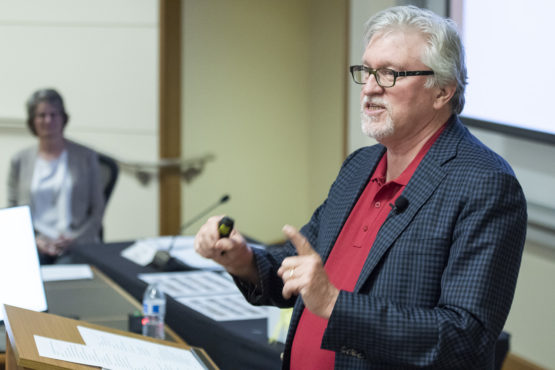Stanford’s off-campus engagement was a central theme of its Board of Trustees’ Feb. 11 and 12 meetings, which also saw approval of two building projects, a discussion on the University’s public arts and a presentation from the new president of the Lucile Packard children’s hospital.
External engagement
As “a major theme” of Stanford’s Long-Range Planning process, presentations regarding the University’s efforts to reach out to entities off campus were a major component of the Trustees’ meetings.
Among these efforts is the discovery task force, co-chaired by Juliet Brodie, law professor and associate dean for clinical education at Stanford Law School, and Marcia Cohen, senior associate dean of finance and administration at the School of Medicine. The task force’s first goal is compiling an inventory of Stanford’s current national and regional outreach efforts — including the University’s partnerships with organizations such as Stanford Live and Athletics, the Cantor Arts Center and other campus museums, Stanford Hospital and the Haas Center for Public Service.
The discovery task force’s next step will be designing “coordinated strategies” for engagement, Board Chair Jeff Raikes ’80 told The Daily.
Trustees also heard two presentations on Stanford’s global engagement efforts: one from Ramón Saldívar, director of the Bing Overseas Studies Program (BOSP), and one from Jonathan Levin, dean of the Graduate School of Business (GSB).
Saldívar delivered an overview of BOSP, highlighting that approximately 1,000 students participate in various BOSP programs each year, either through one of the 11 quarter-long abroad programs or one of the two-week summer overseas seminar programs.
“This is part of the University’s goal to really make sure Stanford undergraduates have incredibly rich set of opportunities for global studies,” Raikes said.
The Trustees then discussed ways to potentially expand BOSP programs to accommodate STEM majors and student-athletes, who often do not have the unit space or time to spend an entire quarter abroad. Possibilities raised included increasing the number of STEM courses offered during quarter-long abroad programs and adding more summer overseas seminars.
Levin’s presentation on the GSB highlighted the fact that more than 40 percent of its students are international, representing 60 different countries. Each Stanford MBA student is required to participate in a global studies experience, through a seminar or internship abroad.
The presentation also touched on the Stanford Seed program, a GSB initiative to help developing economies throughout the world. Seed has programs in Ghana, Kenya, Botswana and India, among others, Levin emphasized.
Campus construction
The Trustees granted design and partial construction approval for the Cabrillo-Dolores faculty homes project, which would remove two existing unoccupied homes just above Mayfield Row across Dolores Street and replace them with seven single-family homes that faculty can purchase. The project is estimated to be completed in 2021, University spokesperson Brad Hayward wrote in an email to The Daily.
“The availability of housing is a big issue in our community,” Raikes said.
The Board also granted design and construction approval for the third phase of the Stanford Auxiliary Library III. Located in Livermore, the Auxiliary Library III provides a space for overflow from on-campus libraries. Books and other media stored there can be transported back to campus upon request.
Arts at Stanford
The Trustees also heard a presentation from Vice President for the Arts Harry Elam and Associate Vice President for Campus Engagement Matthew Tiews on the arts at Stanford. Elam and Tiews highlighted Stanford’s existing arts programs, including the recent renovation of the Frost Amphitheater, which will partner with GoldenVoice and the San Francisco Symphony for a series of concerts at the amphitheater later this year.
“Frost has a long history as an outdoor venue for University events and musical performances,” Raikes said. “We believe these concerts are going to be a great opportunity to bring outdoor music back to Stanford and to share the Stanford arts experience with the broader community.”
Elam and Tiews also discussed the work of the Committee on Public Art, previously convened at the recommendation of the Board to expand public art on Stanford’s campus. Elam and Tiews pointed to the Auguste Rodin sculptures and large abstract sculptures as existing examples of public art on campus, but hope the Committee can design a plan for bringing more artwork to campus.
The Trustees will be also working with the Associated Students of Stanford University’s Nominations Committee to appoint students to the Committee on Public Art, Hayward said.
“These public art pieces give every visitor of Stanford an opportunity to engage with the arts,” Raikes said. “I think they demonstrate the University’s commitment to the arts as a vital part of our educational mission.”
Lucile Packard Children’s Hospital
Paul King, who recently assumed his position as Chief Executive Officer and President of the Lucile Packard Children’s Hospital, also presented to the Trustees on the hospital’s mission and his intention to collaborate with Stanford’s School of Medicine and adult hospital and their partners.
King told the Trustees that he wanted “make sure the experience of every family coming to Lucile Packard is the experience you would want your own family to have,” Raikes told The Daily.
Raikes also praised the “enormous contributions” of the two hospitals and the School of Medicine “to the health and quality of life of the people in Bay Area and Northern California, as well [to] medicine in the nation and around the world.”
“We’re excited about what the future holds,” Raikes said.
Contact Julia Ingram at jmingram ‘at’ stanford.edu.
